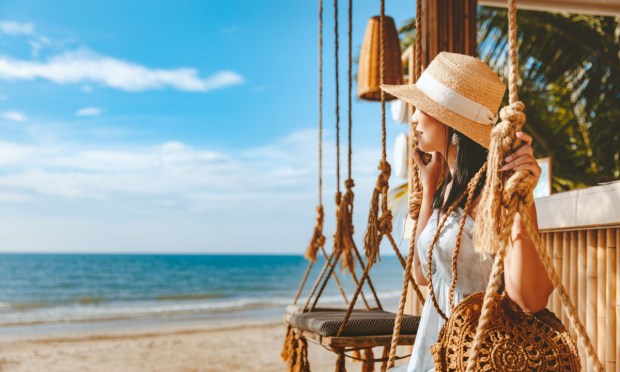The Aspiration Shopper May Be Straying From Luxury and Turning to Travel

The aspirational shopper, once a core target demographic for high-end brands, seems to be in a state of flux. As the traditional luxury market contends with price hikes and changing spending patterns, an interesting trend is emerging — an uptick in the travel sector.
For decades, luxury brands have coveted the aspirational shopper, a consumer who may not have the financial means to consistently purchase their products but seeks to associate with the allure, prestige, and lifestyle these brands represent. Aspirational shoppers often make calculated purchases, investing in a statement piece or an accessory that provides a taste of luxury. However, the current climate of inflation has introduced new complexities into this equation.
Rising prices across various sectors have made traditional luxury purchases more daunting for the aspirational shopper. Basic necessities are consuming a larger share of their budgets, leaving less room for discretionary spending. As a result, luxury brands are beginning to question the viability of their traditional marketing strategies and the effectiveness of targeting this demographic.
Interestingly, as the luxury market grapples with the changing landscape, the travel industry is witnessing a surprising uptick. Despite inflation concerns and economic challenges, consumers are showing an increased willingness to allocate resources to experiences rather than material possessions. This shift aligns with the aspirational shopper’s desire for a taste of luxury, albeit in a different context.
Luxury travel experiences have emerged as a compelling alternative for aspirational shoppers. The allure of exploring exotic destinations, indulging in high-end accommodations and immersing oneself in unique cultural experiences provides a way for individuals to satiate their luxury cravings without the long-term commitment of owning a high-priced item. In this way, travel offers a tangible connection to the world of luxury that is more accessible and experiential.
Recognizing this trend are brands that have strategically leveraged partnerships with travel-related entities, creating a mutually beneficial relationship that allows them to tap into the aspirational shopper’s desire for both luxury goods and memorable experiences.
In June, Ouai, a haircare line, seized a chance for in-flight advertising collaboration with JetBlue, showcasing its St. Barts-scented body products.
The intention behind the advertisement was to conjure a sense of allure, sophistication and sensuality for the audience. The month-spanning campaign, titled “Wanna Get A-Ouai,” was presented as a pre-roll video ahead of JetBlue’s safety demonstration, ensuring visibility to a massive audience of 3 million individuals across 28,000 flights.
Then there’s Moët Hennessy, which launched the inaugural Hennessy shop-in-shop at Zhuhai Duty Free Gongbei Port in China to stimulate demand in the champagne and cognac category.
Revealed in late May, the arrivals boutique at Zhuhai Duty Free Gongbei Port covers is noted to claim 41,870 square feet and stretches across two levels, earning it the distinction of being the largest duty-free establishment at a land port in the Asia Pacific region.
Read also: Moët and Petco Tap Into Shop-In-Shops to Spark Champagne and Pet Essentials Demand
In May, Louis Vuitton ventured into the realm of airport lounges by inaugurating its inaugural branded lounge at Doha airport in partnership with Qatar Airways and Michelin chef Yannick Alléno.
To set itself apart from traditional business class or first-class lounges, Louis Vuitton looked to elevate the lounge experience by infusing sophistication, emotion, and exclusivity into its designed spaces. Instead of functioning solely as a waiting area, the lounge offered a personalized brand encounter that aimed to seamlessly meld with the brand’s diverse services and products. The presence of a Michelin-starred chef and an extensive array of amenities further extended the brand’s reach into upscale hospitality.
In April, PYMNTS reported that designer bags were even making their way into hotels, specifically the Four Seasons, through handbags and accessories rental service Vivrelle.
As part of their collaboration, Vivrelle provided guests at Four Seasons Hotel Houston with complimentary access to its assortment of high-end accessories from prestigious brands like Prada, Gucci, Dior and others.
The report highlighted that, during their stay at the Four Seasons Hotel Houston, guests had the option to change their accessory selection from the meticulously curated hotel collection whenever they wished. This provided them with the opportunity to elevate their appearance for an evening out during their vacation or to introduce a striking piece for a crucial business meeting.
Read more: Luxury Hotels Embrace Embedded Beauty
All of these endeavors align with the most recent data provided by the U.S. Travel Association in May. The data indicated a trend of stabilization in air travel demand, revealing a steady 10% year-over-year (YoY) increase for the month of May. Additionally, there was an enhancement in total travel spending, exceeding the levels recorded in May 2022 by 1.4%. The trend continued through May 2023, showcasing a YoY increase of 5.5%. The inclination towards international travel is apparent in the approaches adopted by different airlines.
As a result, Delta and American Airlines both revised their full-year profit expectations upwards in the month of July. United Airlines reported a quarterly profit and predicted a robust third quarter, attributing this success to the expansion of international travel.
Read also: Delta’s Optimism on Travel Spending Helps CE 100 Index Surge 3.3%
However, JetBlue, primarily a domestic carrier in the U.S., adjusted its full-year profit forecast downward due to the conclusion of its partnership with American Airlines and a shift toward prioritizing international flights over domestic journeys.
